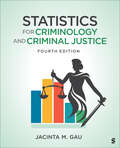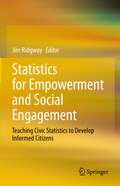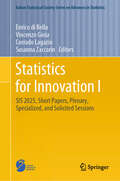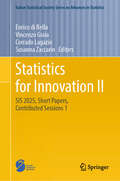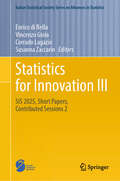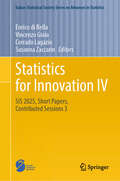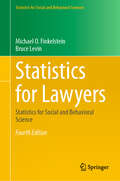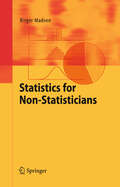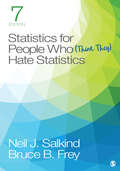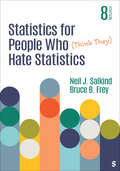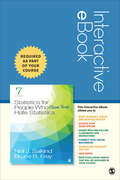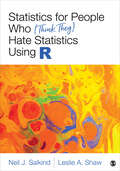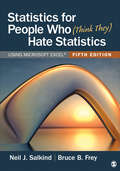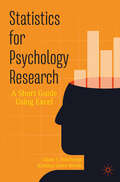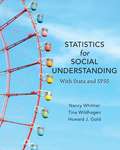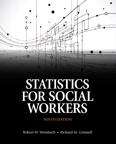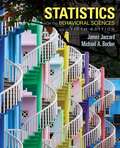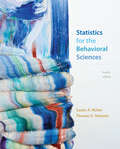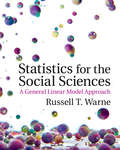- Table View
- List View
Statistics for Criminology and Criminal Justice
by Jacinta M. GauStatistics for Criminology and Criminal Justice, Fourth Edition demonstrates the relevancy of statistics in an age of artificial intelligence (AI), deep fakes, and misinformation by helping students ask the right questions so that they can be open-minded but sufficiently skeptical. Jacinta M. Gau uses conversational language to break down complicated concepts, presents statistical tests step by step, and uses SPSS to guide students through obtaining and interpreting output. New to the Fourth Edition are updated examples including the #MeToo and racial justice movements’ impact on the criminal justice system, implications of AI for fraud and cybercrime, and the increasing prevalence of mass casualty events. New data sets are provided, and many Critical Thinking Questions, Learning Checks, Chapter Review Questions have been expanded and updated. These changes reflect a commitment to making statistics more approachable and engaging for students, with a focus on real-world applications and critical thinking.
Statistics for Empowerment and Social Engagement: Teaching Civic Statistics to Develop Informed Citizens
by Jim Ridgway“This book is a remarkable achievement” Gerd GigerenzerThis book offers practical approaches to working in a new field of knowledge - Civic Statistics - which sets out to engage with, and overcome well documented and long-standing problems in teaching quantitative skills. The book includes 23 peer-reviewed chapters, written in coordination by an international group of experts from ten countries. The book aims to support and enhance the work of teachers and lecturers working both at the high school and tertiary (university) levels. It is designed to promote and improve the critical understanding of quantitative evidence relevant to burning social issues – such as epidemics, climate change, poverty, migration, natural disasters, inequality, employment, and racism.Effective citizen engagement with social issues requires active participation and a broad understanding of data and statistics about societal issues. However, many statistics curricula are not designed to teach relevant skills nor to improve learners' statistical literacy. Evidence about social issues is provided to the public via print and digital media, official statistics offices, and other information channels, and a great deal of data is accessible both as aggregated summaries and as individual records. Chapters illustrate the approaches needed to teach and promote the knowledge, skills, dispositions, and enabling processes associated with critical understanding of Civic Statistics presented in many forms. These include: statistical analysis of authentic multivariate data; use of dynamic data visualisations; deconstructing texts about the social and economic well-being of societies and communities. Chapters discuss: the development of curricula and educational resources; use of emerging technologies and visualizations; preparation of teachers and teaching approaches; sources for relevant datasets and rich texts about Civic Statistics; ideas regarding future research, assessment, collaborations between different stakeholders; and other systemic issues.
Statistics for Innovation I: SIS 2025, Short Papers, Plenary, Specialized, and Solicited Sessions (Italian Statistical Society Series on Advances in Statistics)
by Enrico Di Bella Vincenzo Gioia Corrado Lagazio Susanna ZaccarinThis book presents peer-reviewed short papers on methodological and applied statistical research presented at the Italian Statistical Society&’s international conference on &“Statistics for Innovation&”, SIS 2025, held in Genoa, Italy, June 16-18, 2025. It is the first of four volumes, featuring invited contributions presented in the Plenary, Specialized and Solicited Sessions. Providing a comprehensive overview of innovations in modern statistical methods and applications, the volumes address a large number of topics of current interest, contributing to a rapid dissemination of quantitative methods for data analysis across the various fields of scientific research and social life. The volumes underpin the role of statistics and data science in fostering innovation in numerous fields, including business, industry, finance, technology, environment, health and medicine, official statistics, public policy, welfare, social issues and sustainable development. One of the aims of the Italian Statistical Society (SIS) is to promote scientific activities for the development of statistical sciences. Together with the biennial international Scientific Meeting, the intermediate international statistical conferences on a particular topic of interest represent the Society&’s most important events which bring together national and international researchers and professionals to exchange ideas and discuss recent advances and developments in theoretical and applied statistics.
Statistics for Innovation II: SIS 2025, Short Papers, Contributed Sessions 1 (Italian Statistical Society Series on Advances in Statistics)
by Enrico Di Bella Vincenzo Gioia Corrado Lagazio Susanna ZaccarinThis book presents peer-reviewed short papers on methodological and applied statistical research presented at the Italian Statistical Society&’s international conference on &“Statistics for Innovation&”, SIS 2025, held in Genoa, Italy, June 16-18, 2025. It is the second of four volumes, featuring the first part of the contributions presented in the Contributed Sessions. Providing a comprehensive overview of innovations in modern statistical methods and applications, the volumes address a large number of topics of current interest, contributing to a rapid dissemination of quantitative methods for data analysis across the various fields of scientific research and social life. The volumes underpin the role of statistics and data science in fostering innovation in numerous fields, including business, industry, finance, technology, environment, health and medicine, official statistics, public policy, welfare, social issues and sustainable development. One of the aims of the Italian Statistical Society (SIS) is to promote scientific activities for the development of statistical sciences. Together with the biennial international Scientific Meeting, the intermediate international statistical conferences on a particular topic of interest represent the Society&’s most important events which bring together national and international researchers and professionals to exchange ideas and discuss recent advances and developments in theoretical and applied statistics.
Statistics for Innovation III: SIS 2025, Short Papers, Contributed Sessions 2 (Italian Statistical Society Series on Advances in Statistics)
by Enrico Di Bella Vincenzo Gioia Corrado Lagazio Susanna ZaccarinThis book presents peer-reviewed short papers on methodological and applied statistical research presented at the Italian Statistical Society&’s international conference on &“Statistics for Innovation&”, SIS 2025, held in Genoa, Italy, June 16-18, 2025. It is the third of four volumes, featuring the second part of the contributions presented in the Contributed Sessions. Providing a comprehensive overview of innovations in modern statistical methods and applications, the volumes address a large number of topics of current interest, contributing to a rapid dissemination of quantitative methods for data analysis across the various fields of scientific research and social life. The volumes underpin the role of statistics and data science in fostering innovation in numerous fields, including business, industry, finance, technology, environment, health and medicine, official statistics, public policy, welfare, social issues and sustainable development. One of the aims of the Italian Statistical Society (SIS) is to promote scientific activities for the development of statistical sciences. Together with the biennial international Scientific Meeting, the intermediate international statistical conferences on a particular topic of interest represent the Society&’s most important events which bring together national and international researchers and professionals to exchange ideas and discuss recent advances and developments in theoretical and applied statistics.
Statistics for Innovation IV: SIS 2025, Short Papers, Contributed Sessions 3 (Italian Statistical Society Series on Advances in Statistics)
by Enrico Di Bella Vincenzo Gioia Corrado Lagazio Susanna ZaccarinThis book presents peer-reviewed short papers on methodological and applied statistical research presented at the Italian Statistical Society&’s international conference on &“Statistics for Innovation&”, SIS 2025, held in Genoa, Italy, June 16-18, 2025. It is the last of four volumes, featuring the third part of the contributions presented in the Contributed Sessions. Providing a comprehensive overview of innovations in modern statistical methods and applications, the volumes address a large number of topics of current interest, contributing to a rapid dissemination of quantitative methods for data analysis across the various fields of scientific research and social life. The volumes underpin the role of statistics and data science in fostering innovation in numerous fields, including business, industry, finance, technology, environment, health and medicine, official statistics, public policy, welfare, social issues and sustainable development. One of the aims of the Italian Statistical Society (SIS) is to promote scientific activities for the development of statistical sciences. Together with the biennial international Scientific Meeting, the intermediate international statistical conferences on a particular topic of interest represent the Society&’s most important events which bring together national and international researchers and professionals to exchange ideas and discuss recent advances and developments in theoretical and applied statistics.
Statistics for Lawyers: Statistics for Social and Behavioral Science (Statistics for Social and Behavioral Sciences #189)
by Michael O. Finkelstein Bruce LevinThis classic text, first published in 1990, is designed to introduce law students, law teachers, practitioners, and judges to the basic ideas of mathematical probability and statistics as they have been applied in the law. The fourth edition includes fourteen new sections, four inserts to the statistical text, and six new answer sections, on topics including the following: Use of prior probabilities after DNA database searches; Lipitor and diabetes; Harvard’s affirmative action practices in admissions; New York City garbage trucks; Tests of odds ratio homogeneity; Disparate impact of a pre-employment exam on minority applicants; Liraglutide and pancreatic cancer; Representative sampling; Reversals in death-penalty cases; Technology assisted review in e-discovery; Asbestos and colon cancer; Guilty pleas in the federal courts; The “financing secured” event study; and Average marginal effects. The book consists of sections of exposition followed by real-world cases and case studies in which statistical data have played a role. The reader is asked to apply the theory to the facts, to calculate results (a hand calculator is sufficient), and to explore legal issues raised by quantitative findings. The authors' calculations and comments are given in the back of the book. As with previous editions, the cases and case studies reflect a broad variety of legal subjects, including antidiscrimination, mass torts, taxation, school finance, identification evidence, preventive detention, handwriting disputes, voting, environmental protection, antitrust, sampling for insurance audits, and the death penalty.
Statistics for Non-Statisticians
by Birger MadsenThis book was written for those who need to know how to collect, analyze and present data. It is meant to be a first course for practitioners, a book for private study or brush-up on statistics, and supplementary reading for general statistics classes. The book is untraditional, both with respect to the choice of topics and the presentation. The topics were determined by what is most useful for practical statistical work: even experienced statisticians will find new topics or new approaches to traditional topics. The presentation is as non-mathematical as possible. Mathematical formulae are presented only if they are necessary for calculations and/or add to readers' understanding. A sample survey is developed as a realistic example throughout the book, and many further examples are presented, which also use data spreadsheets from a supplementary website.
Statistics for People Who (Think They) Hate Statistics
by Bruce B. Frey Neil J. SalkindNow in its Seventh Edition, Neil J. Salkind’s bestselling Statistics for People Who (Think They) Hate Statistics with new co-author Bruce B. Frey teaches an often intimidating subject with a humorous, personable, and informative approach that reduces statistics anxiety. With instruction in SPSS®, the authors guide students through basic and advanced statistical procedures, from correlation and graph creation to analysis of variance, regression, non-parametric tests, and more. The Seventh Edition includes new real-world examples, additional coverage on multiple regression and power and effect size, and a robust interactive eBook with video tutorials and animations of key concepts. In the end, students who (think they) hate statistics will understand how to explain the results of many statistical analyses and won’t be intimidated by basic statistical tasks. A Complete Teaching & Learning Package accompanies the Seventh Edition! Interactive eBook: Save when bundled with the Seventh Edition. Includes access to SAGE Premium Video, multimedia tools, and much more Use bundle ISBN: 978-1-5443-9339-1. SAGE Premium Video includes animated Core Concepts in Stats Videos, Lightboard Lecture Videos from Bruce B. Frey, and tutorial videos for end-of-chapter of SPSS problems. Only available in the Interactive eBook. SAGE edge: FREE online resources for students that make learning easier. SAGE coursepacks: FREE! Easily import our quality instructor and student resource content into your school’s learning management system (LMS) and save time. Study Guides: only $5 when bundled with Statistics for People Who (Think They) Hate Statistics, 7e. To order: Study Guide and Interactive eBook bundle (ISBN 978-1-5443-9752-8) Study Guide for Psychology and Interactive eBook bundle (ISBN 978-1-5443-9753-5) Study Guide for Education and Interactive eBook bundle (ISBN 978-1-5443-9754-2) Study Guide for Health & Nursing and Interactive eBook bundle (ISBN 978-1-5443-9755-9)
Statistics for People Who (Think They) Hate Statistics
by Bruce B. Frey Neil J. SalkindNow in its Seventh Edition, Neil J. Salkind’s bestselling Statistics for People Who (Think They) Hate Statistics with new co-author Bruce B. Frey teaches an often intimidating subject with a humorous, personable, and informative approach that reduces statistics anxiety. With instruction in SPSS®, the authors guide students through basic and advanced statistical procedures, from correlation and graph creation to analysis of variance, regression, non-parametric tests, and more. The Seventh Edition includes new real-world examples, additional coverage on multiple regression and power and effect size, and a robust interactive eBook with video tutorials and animations of key concepts. In the end, students who (think they) hate statistics will understand how to explain the results of many statistical analyses and won’t be intimidated by basic statistical tasks. A Complete Teaching & Learning Package accompanies the Seventh Edition! Interactive eBook: Save when bundled with the Seventh Edition. Includes access to SAGE Premium Video, multimedia tools, and much more Use bundle ISBN: 978-1-5443-9339-1. SAGE Premium Video includes animated Core Concepts in Stats Videos, Lightboard Lecture Videos from Bruce B. Frey, and tutorial videos for end-of-chapter of SPSS problems. Only available in the Interactive eBook. SAGE edge: FREE online resources for students that make learning easier. SAGE coursepacks: FREE! Easily import our quality instructor and student resource content into your school’s learning management system (LMS) and save time. Study Guides: only $5 when bundled with Statistics for People Who (Think They) Hate Statistics, 7e. To order: Study Guide and Interactive eBook bundle (ISBN 978-1-5443-9752-8) Study Guide for Psychology and Interactive eBook bundle (ISBN 978-1-5443-9753-5) Study Guide for Education and Interactive eBook bundle (ISBN 978-1-5443-9754-2) Study Guide for Health & Nursing and Interactive eBook bundle (ISBN 978-1-5443-9755-9)
Statistics for People Who (Think They) Hate Statistics
by Bruce B. Frey Neil J. SalkindThe bestselling Statistics for People Who (Think They) Hate Statistics teaches an often intimidating and difficult subject in a way that is informative, personable, and clear. The authors take students through various statistical procedures, beginning with correlation and graphical representation of data and ending with inferential techniques and analysis of variance. In addition, the text provides instruction in SPSS®, and includes reviews of more advanced techniques, such as reliability, validity, introductory non-parametric statistics, and more. The Eighth Edition features a streamlined structure, reducing the total chapters from 19 to 14 for improved clarity and focus. Content has been thoroughly revised for better readability, and the text is now available in full color. It′s also available in Sage Vantage, an easy-to-use learning platform that offers practice problems, end-of-chapter quizzes, author videos, data activities, and other interactive tools to support student learning.
Statistics for People Who (Think They) Hate Statistics
by Bruce B. Frey Neil J. SalkindThe bestselling Statistics for People Who (Think They) Hate Statistics teaches an often intimidating and difficult subject in a way that is informative, personable, and clear. The authors take students through various statistical procedures, beginning with correlation and graphical representation of data and ending with inferential techniques and analysis of variance. In addition, the text provides instruction in SPSS®, and includes reviews of more advanced techniques, such as reliability, validity, introductory non-parametric statistics, and more. The Eighth Edition features a streamlined structure, reducing the total chapters from 19 to 14 for improved clarity and focus. Content has been thoroughly revised for better readability, and the text is now available in full color. It′s also available in Sage Vantage, an easy-to-use learning platform that offers practice problems, end-of-chapter quizzes, author videos, data activities, and other interactive tools to support student learning.
Statistics for People Who (Think They) Hate Statistics - Interactive eBook
by Neil J. Salkind Bruce B. FreyThis Interactive eBook includes access to SAGE Premium Video and much more! STUDENTS: Still need to purchase your eBook access code? For instant access, get your copy of this interactive eBook at vitalsource.com. Prefer a shipped option? Click on the "BUY NOW" button on this page and select the "Slim Pack" (shipped access code) version from the drop-down menu. Your interactive eBook access code will be shipped to the address you indicate in your order form. Please note: shipping fees apply. You will have 180 days of access with this Slim Pack option. INSTRUCTORS: Bundle and save! Order using bundle ISBN: 978-1-5443-9339-1 (interactive eBook + print) Note: Instant access is not available with interactive eBook + print bundles. All bundles will ship with the print version and corresponding interactive eBook 180-day rental access code information (slim pack). This dynamic, mobile-friendly interactive eBook version of Statistics for People Who (Think They) Hate Statistics, 7e goes way beyond highlighting and note-taking, giving you access to SAGE Premium Video—curated and produced specifically for this text. Simply click on icons in the eBook to experience a broad array of multimedia features, including: VIDEO: Boost learning and bolster analysis with SAGE Premium Video. Recapping the fundamentals in every chapter, video activities are paired with chapter learning objectives and tied to assessment via SAGE coursepacks. Videos include animated Core Concepts in Stats Videos, Lightboard Lecture Videos with Bruce B. Frey, and tutorial videos for end-of-chapter of SPSS® problems. AUDIO: Listen to engaging podcasts and audio resources that supplement and enrich key points within the text. OFFLINE READING: Using the VitalSource Bookshelf® platform, download your book to a personal computer and read it offline. SOCIAL SHARING AND FOLLOWING: Share notes and highlights with instructors and classmates who are using the same eBook, and "follow" friends and instructors as they make their own notes and highlights. Need a Personalized Demo? Contact your sales representative today.
Statistics for People Who (Think They) Hate Statistics Using R
by Dr. Neil J. Salkind Leslie A. ShawNeil J. Salkind’s bestselling Statistics for People Who (Think They) Hate Statistics has been helping ease student anxiety around an often intimidating subject since it first published in 2000. Now the bestselling SPSS® and Excel® versions are joined by a text for use with the R software, Statistics for People Who (Think They) Hate Statistics Using R. New co-author Leslie A. Shaw carries forward Salkind’s signature humorous, personable, and informative approach as the text guides students in a grounding of statistical basics and R computing, and the application of statistics to research studies. The book covers various basic and advanced statistical procedures, from correlation and graph creation to analysis of variance, regression, non-parametric tests, and more.
Statistics for People Who (Think They) Hate Statistics Using R
by Dr. Neil J. Salkind Leslie A. ShawNeil J. Salkind’s bestselling Statistics for People Who (Think They) Hate Statistics has been helping ease student anxiety around an often intimidating subject since it first published in 2000. Now the bestselling SPSS® and Excel® versions are joined by a text for use with the R software, Statistics for People Who (Think They) Hate Statistics Using R. New co-author Leslie A. Shaw carries forward Salkind’s signature humorous, personable, and informative approach as the text guides students in a grounding of statistical basics and R computing, and the application of statistics to research studies. The book covers various basic and advanced statistical procedures, from correlation and graph creation to analysis of variance, regression, non-parametric tests, and more.
Statistics for People Who (Think They) Hate Statistics: Using Microsoft Excel
by Bruce B. Frey Neil J. SalkindThis Fifth Edition of Neil J. Salkind’s Statistics for People Who (Think They) Hate Statistics: Using Microsoft Excel, presents an often intimidating and difficult subject in a way that is clear, informative, and personable. Opening with an introduction to Excel, including coverage of how to use functions and formulas, this edition shows students how to install the Excel Data Analysis Tools option to access a host of useful analytical techniques. New to the Fifth Edition is new co-author Bruce Frey who has added a new feature on statisticians throughout history (with a focus on the contributions of women and people of color). He has updated the "Real-World Stats" feature, and added more on effect sizes, updated the discussions on hypotheses, measurement concepts like validity and reliability, and has more closely tied analytical choices to the level of measurement of variables.
Statistics for People Who (Think They) Hate Statistics: Using Microsoft Excel
by Bruce B. Frey Neil J. SalkindThis Fifth Edition of Neil J. Salkind’s Statistics for People Who (Think They) Hate Statistics: Using Microsoft Excel, presents an often intimidating and difficult subject in a way that is clear, informative, and personable. Opening with an introduction to Excel, including coverage of how to use functions and formulas, this edition shows students how to install the Excel Data Analysis Tools option to access a host of useful analytical techniques. New to the Fifth Edition is new co-author Bruce Frey who has added a new feature on statisticians throughout history (with a focus on the contributions of women and people of color). He has updated the "Real-World Stats" feature, and added more on effect sizes, updated the discussions on hypotheses, measurement concepts like validity and reliability, and has more closely tied analytical choices to the level of measurement of variables.
Statistics for Psychology Research: A Short Guide Using Excel
by Adam T. Hutcheson Kristina Groce BrownThis book aims to help psychology students build their skills to conduct research and analyses using Microsoft Excel’s Data Analysis Toolpak. Concise yet comprehensive, this accessible textbook walks students through basic research methodology, central tendency, variability, standardized scores, t-tests (independent and related samples), One-way Analysis of Variance (between-groups and repeated measures), the Pearson correlation, and Chi Square analyses. Each chapter includes examples of research questions to be addressed, the rationale for the analysis, a step-by-step analysis of the dataset in equation format and using Microsoft Excel, and how to present results in APA (7th Edition) style. The extensive didactic material encompasses end-of-chapter questions, learning outcomes, sidebar boxes with common mistakes to avoid, and biographical sketches of those who developed research methods and statistical techniques. Students and instructors will also benefit from a companion website where PowerPoint slides and additional exercises, datasets, and resources are available. Ideal for undergraduate psychology courses, this textbook can also be of use for those interested in learning more about statistical research and its practical application at university and beyond. Test your knowledge with questions and answers about the book with Springer Nature Flashcards.
Statistics for Social Understanding: With Stata and SPSS
by Nancy Whittier Howard J. Gold Tina WildhagenStatistics for Social Understanding: With Stata and SPSS introduces students to the way statistics is used in the social sciences--as a tool for advancing understanding of the social world. Written in an engaging and clear voice and based on the latest research on the teaching and learning of quantitative material, the text is geared to introductory students in the social sciences, including those with little quantitative background. It covers the conceptual aspects of statistics even when the mathematical details are minimized. Informed by research on teaching and learning in statistics, the book takes a universal design approach to accommodate diverse learning styles. With an early chapter on cross-tabulation, a focus on comparisons between groups throughout, and a unique chapter on causality, the text shows students the power of statistics for answering important real-world questions. By providing thorough coverage of social science statistical topics, a balanced approach to calculation, and step-by-step directions on how to use statistical software, authors Nancy Whittier, Tina Wildhagen, and Howard J. Gold give students the ability to analyze data and explore and answer exciting questions. To accommodate changing undergraduate courses, the text incorporates examples from both Stata and SPSS in every chapter and provides practice problems of every type as well as readily available datasets for classroom use, including the General Social Survey, American National Election Study, and more. Each chapter concludes with a chapter summary, a section on using Stata, a section on using SPSS, and practice problems. Statistics for Social Understanding: With Stata and SPSS is accompanied by a learning package, written entirely by Tina Wildhagen, that is designed to enhance the experience of both instructors and students. Author-written ancillaries ensure that supplementary materials match the text in voice, language, and content.
Statistics for Social Work With SPSS
by Serge LeeThis book provides readers with a user-friendly, evidence-based, and practical resource to help them make sense of, organize, analyze, and interpret data in contemporary contexts. It incorporates one of the most well-known statistics software applications, the Statistical Package for the Social Science (SPSS), within each chapter to help readers integrate their knowledge either manually or with the assistance of technology. The book begins with a brief introduction to statistics and research, followed by chapters that address variables, frequency distributions, measures of central tendency, and measures of variability. Additional chapters cover probability and hypothesis testing; normal distribution and Z score; correlation; simple linear regression; one-way ANOVA; and more. Each chapter features concise, simple explanations of key terms, formulas, and calculations; study questions and answers; specific SPSS instructions on computerized computations; and evidence-based, practical examples to support the learning experience. Presenting students with highly accessible and universally understandable statistical concepts, this is an ideal textbook for undergraduate and graduate-level courses in social work statistics, as well as research-based courses within the social and behavioral sciences.
Statistics for Social Workers (Ninth Edition)
by Robert W. Weinbach Richard M. GrinnellThis book intends to be a reference for social work practitioners who, increasingly, are involved in agency-based research projects, and who must critically evaluate the reports of research findings in order to remain effective evidence-based practitioners.
Statistics for the Behavioral Sciences
by James Jaccard Michael A. BeckerNow you can become an intelligent consumer of scientific research, without being overwhelmed by the statistics! Jaccard and Becker's book teaches readers the basic skills for analyzing data and helps them become intelligent consumers of scientific information. Praised for its real-life applications, the book tells readers when to use a particular statistic, why they should use it, and how the statistic should be computed and interpreted. Because many readers, given a set of data, cannot determine where to begin in answering relevant research questions, the authors explicate the issues involved in selecting a statistical test. Each statistical technique is introduced by giving instances where the test is most typically applied followed by an interesting research example (each example is taken from psychology literature).
Statistics for the Behavioral Sciences (2nd Edition)
by Susan A. Nolan Thomas E. HeinzenIn this new edition, author tries to connect students to statistical concepts efficiently and refocuses on the core concepts of the course and introduces each topic with a vivid example.
Statistics for the Behavioral Sciences (Fourth Edition)
by Susan A. Nolan Thomas E. HeinzenNolan and Heinzen offer an introduction to the basics of statistics that is uniquely suited for behavioral science students, with coverage anchor to real-world stories, a highly visual approach, helpful mathematical support, and step-by-step examples. The new edition focuses on emerging trends that are redefining contemporary behavioral statistics.
Statistics for the Social Sciences
by Russell T. WarneWritten by a quantitative psychologist, this textbook explains complex statistics in accessible language to undergraduates in all branches of the social sciences. Built around the central framework of the General Linear Model (GLM), Statistics for the Social Sciences teaches students how different statistical methods are interrelated to one another. With the GLM as a basis, students with varying levels of background are better equipped to interpret statistics and learn more advanced methods in their later courses. Russell Warne makes statistics relevant to students' varying majors by using fascinating real-life examples from the social sciences. Students who use this book will benefit from clear explanations, warnings against common erroneous beliefs about statistics, and the latest developments in the philosophy, reporting and practice of statistics in the social sciences. The textbook is packed with helpful pedagogical features including learning goals, guided practice and reflection questions.
